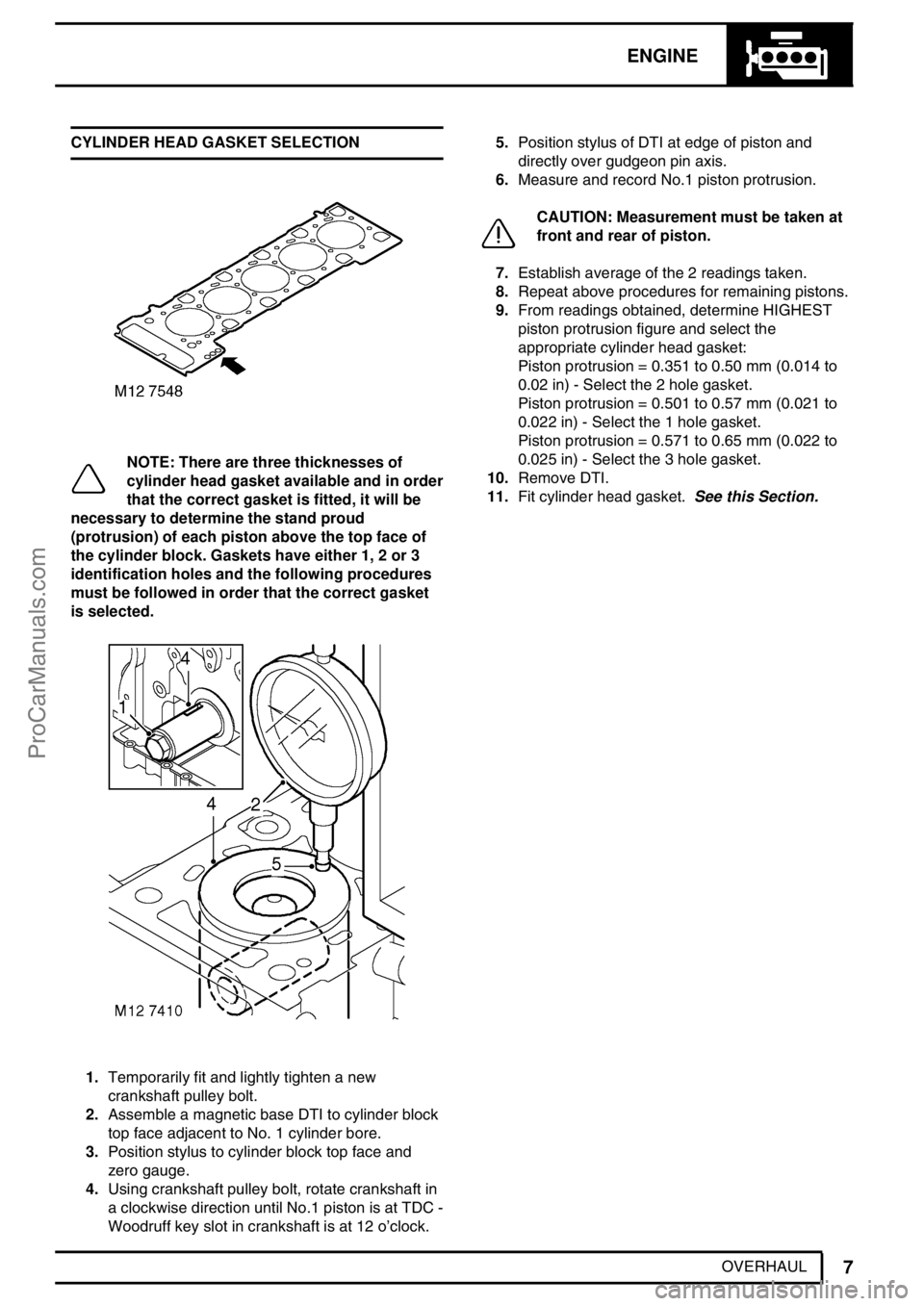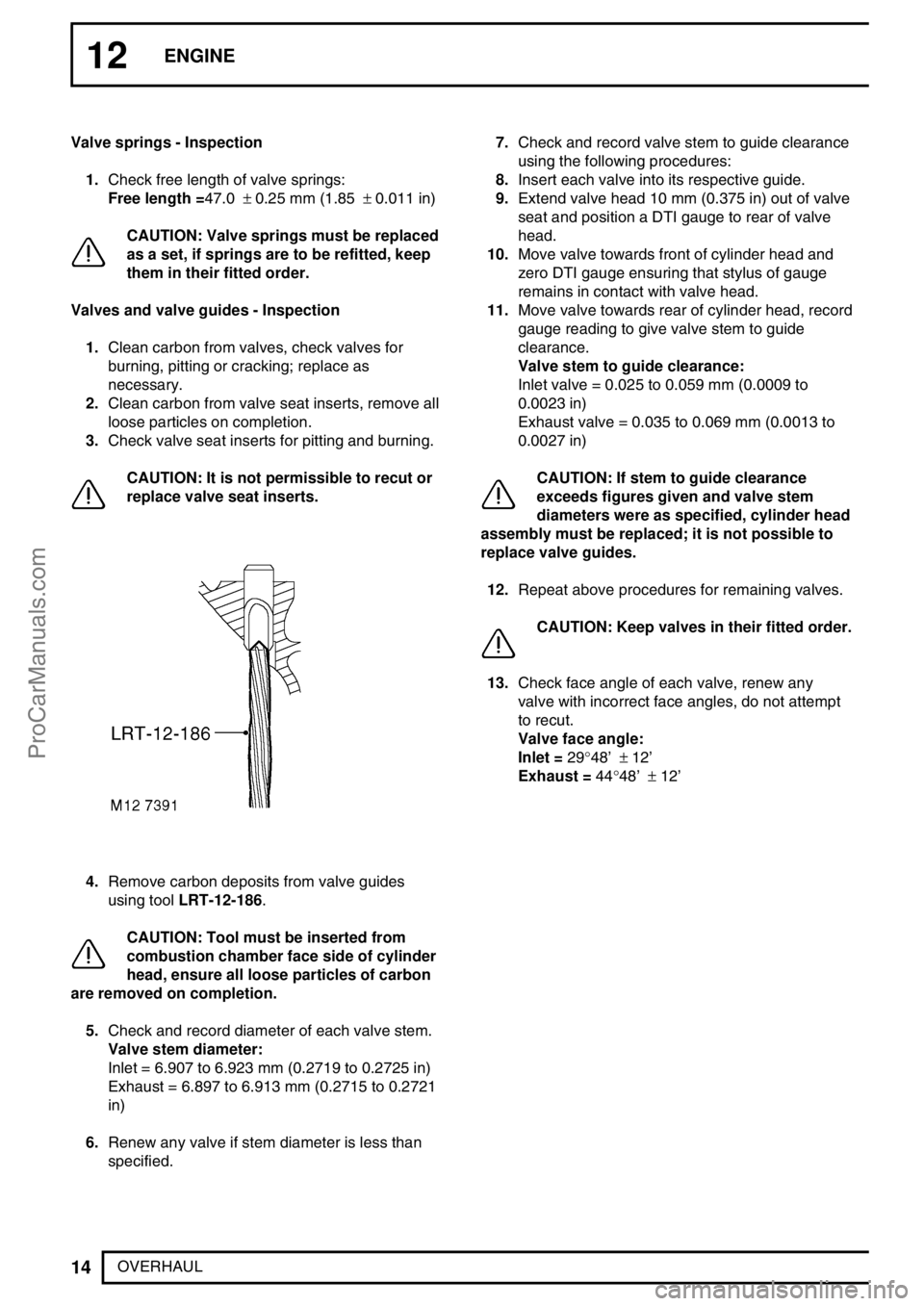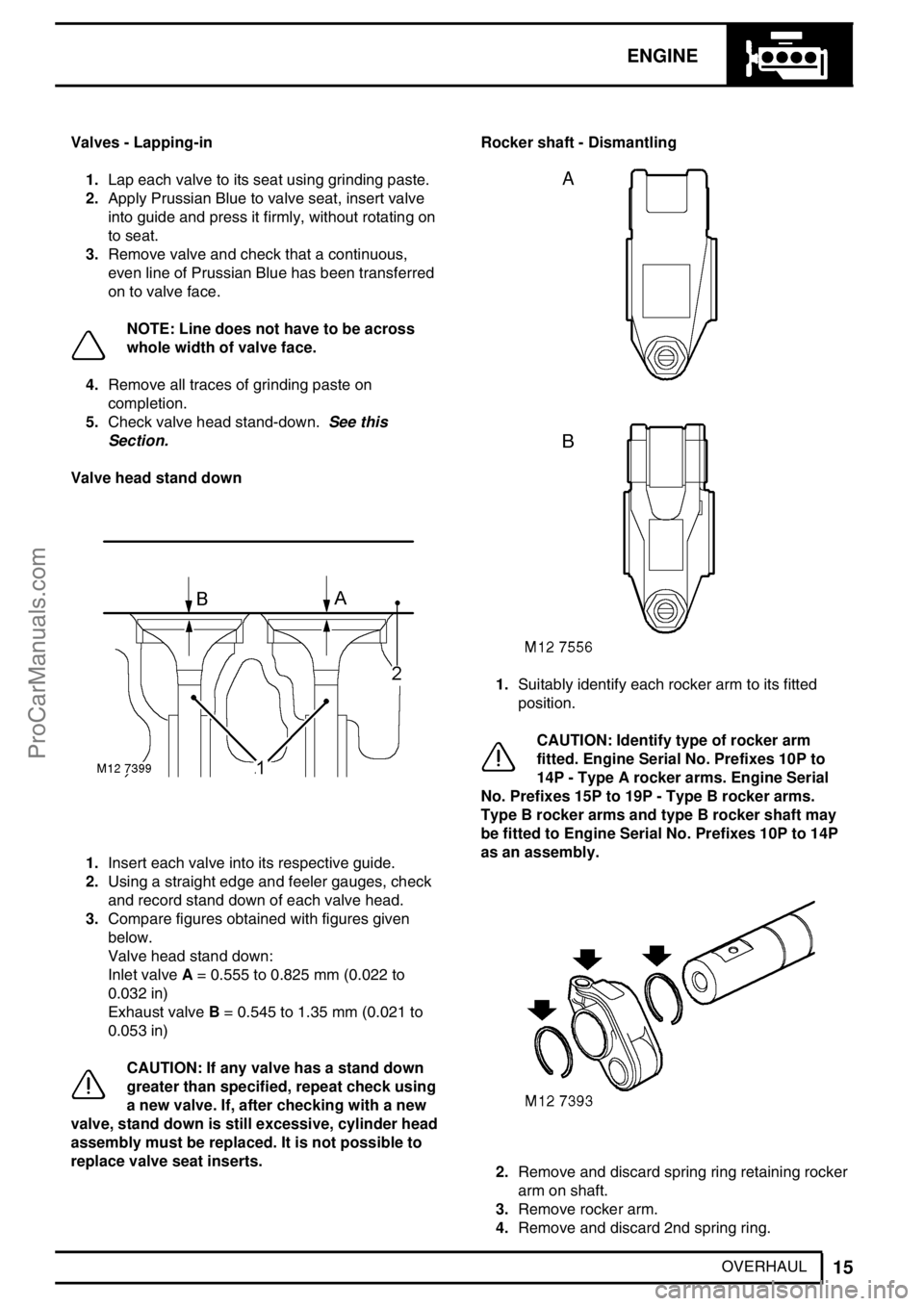engine LAND ROVER DEFENDER 1999 Workshop Manual
[x] Cancel search | Manufacturer: LAND ROVER, Model Year: 1999, Model line: DEFENDER, Model: LAND ROVER DEFENDER 1999Pages: 667, PDF Size: 8.76 MB
Page 165 of 667

12ENGINE
6
OVERHAUL 14.Clean fixed guide Allen screw and apply Loctite
242 to screw threads.
15.Fit fixed timing chain guide Allen screw and
tighten to25 Nm (18 lbf.ft).
16.Clean timing chain tensioner and fit new sealing
washer.
17.Fit timing chain tensioner and tighten to45 Nm
(33 lbf.ft).
18.Tighten camshaft sprocket bolts to36 Nm (27
lbf.ft).
19.Remove toolLRT-12-058from camshaft.
20.Lubricate a new’O’ring with engine oil and fit to
camshaft sprocket access plug.
21.Fit camshaft sprocket access plug.
22.Clean alternator/vacuum pump oil feed hose
union.
23.Lubricate a new’O’ring with engine oil and fit to
alternator/vacuum pump hose union.
24.Fit and tighten alternator/vacuum pump oil hose
union to10 Nm (7 lbf.ft).
25.Fit bolt securing alternator strap bracket to
cylinder head and tighten to25 Nm (18 lbf.ft).
26.Connect multiplugs to ECT sensor and EUIs.
CAUTION: Following cylinder head
overhaul, it will be necessary, before
fitting the camshaft cover, to adjust the
fuel injector rockers using the following
procedures:
27.Rotate engine clockwise until No. 1 EUI lobe is
at full lift.
28.Tighten No.1 rocker adjusting screw until the EUI
plunger is felt to’bottom out’.
29.Loosen rocker adjusting screw 1 complete turn
to give EUI plunger the required bump clearance
and tighten rocker adjusting screw locknut to16
Nm (12 lbf.ft).
CAUTION: Ensure screw does not turn as
locknut is tightened.30.Carry out above procedures for the remaining 4
rocker arms.
31.After completion of rocker adjustment, slowly
rotate engine clockwise 2 complete turns by
hand to ensure that no EUI’s are bottoming out
on their plungers.
32.Clean camshaft cover and mating face.
33.Fit new sealing washers and isolators as
necessary to camshaft cover.
34.Fit new camshaft cover gasket to cover.
CAUTION: Gasket must be fitted dry.
35.Fit camshaft cover to camshaft carrier, fit bolts
and working from the centre outwards, tighten
bolts to10 Nm (7 lbf.ft).
36.Fit inlet manifold gasket.See MANIFOLD AND
EXHAUST SYSTEM, Repair.
37.Fit exhaust manifold gasket.See MANIFOLD
AND EXHAUST SYSTEM, Repair.
38. EGR cooler fitted:-Position EGR pipe to cooler,
fit new Allen screws and tighten to10 Nm (7
lbf.ft).
ProCarManuals.com
Page 166 of 667

ENGINE
7
OVERHAUL CYLINDER HEAD GASKET SELECTION
NOTE: There are three thicknesses of
cylinder head gasket available and in order
that the correct gasket is fitted, it will be
necessary to determine the stand proud
(protrusion) of each piston above the top face of
the cylinder block. Gaskets have either 1, 2 or 3
identification holes and the following procedures
must be followed in order that the correct gasket
is selected.
1.Temporarily fit and lightly tighten a new
crankshaft pulley bolt.
2.Assemble a magnetic base DTI to cylinder block
top face adjacent to No. 1 cylinder bore.
3.Position stylus to cylinder block top face and
zero gauge.
4.Using crankshaft pulley bolt, rotate crankshaft in
a clockwise direction until No.1 piston is at TDC -
Woodruff key slot in crankshaft is at 12 o’clock.5.Position stylus of DTI at edge of piston and
directly over gudgeon pin axis.
6.Measure and record No.1 piston protrusion.
CAUTION: Measurement must be taken at
front and rear of piston.
7.Establish average of the 2 readings taken.
8.Repeat above procedures for remaining pistons.
9.From readings obtained, determine HIGHEST
piston protrusion figure and select the
appropriate cylinder head gasket:
Piston protrusion = 0.351 to 0.50 mm (0.014 to
0.02 in) - Select the 2 hole gasket.
Piston protrusion = 0.501 to 0.57 mm (0.021 to
0.022 in) - Select the 1 hole gasket.
Piston protrusion = 0.571 to 0.65 mm (0.022 to
0.025 in) - Select the 3 hole gasket.
10.Remove DTI.
11.Fit cylinder head gasket.See this Section.
ProCarManuals.com
Page 167 of 667

12ENGINE
8
OVERHAUL CYLINDER HEAD - OVERHAUL
Service repair no - 12.29.19.01
Dismantling
1.Remove cylinder head gasket.See this
Section.
CAUTION: Due to the design of the
cylinder head which incorporates drillings
for the fuel injection system, it is important
that absolute cleanliness is adhered to when
carrying out overhaul procedures.
2.Note the gasket thickness indicator and ensure
the same thickness gasket is used on refitment
of cylinder head.
CAUTION: If new pistons, connecting rods
or crankshaft are fitted, it will be
necessary to determine thickness of
gasket required.See this Section.
3.Remove 4 glow plugs.
4.Disconnect multiplugs from EUI’s and remove
harness from camshaft carrier. Remove and
discard’O’ring from harness multiplug.
5.Loosen lock nuts and fully unscrew rocker
adjusting screws; discard locknuts and screws.
6.Remove and discard 6 bolts securing rocker
shaft, remove shaft.
NOTE: Dowel located.
7.Using sequence shown, progressively loosen 13
bolts securing camshaft carrier to cylinder head
until valve spring pressure is released; remove
bolts.
CAUTION: Do not discard bolts at this
stage.
ProCarManuals.com
Page 168 of 667

ENGINE
9
OVERHAUL
8.Gently tap camshaft carrier upwards to break
sealant bond, remove carrier.
NOTE: Dowel located.
9.Remove camshaft.
10.Remove and discard camshaft rear oil seal.
11.Remove finger followers and lash adjusters.
CAUTION: Store lash adjusters and finger
followers in their fitted order and store
lash adjusters upright. Maintain absolute
cleanliness when handling components.
12.Remove and discard 5 bolts securing EUI
retainers.
13.Using toolLRT-12-154/1remove EUI units from
cylinder head and collect retainers. Remove
reaction posts and keep in their fitted order.
14.Using toolLRT-12-154/4, remove and discard
sealing washer and’O’ring from each EUI unit.
15.Support cylinder head clear of valves, use a
hollow drift and tap each valve spring cap to free
collets.
16.Using toolLRT-12-034, compress valve spring.
17.Remove 2 collets from valve stem using a stick
magnet.
18.Remove toolLRT-12-034.
19.Remove valve spring cap, valve spring and
valve.
CAUTION: Keep components in their fitted
order.
ProCarManuals.com
Page 169 of 667

12ENGINE
10
OVERHAUL
20.Using toolLRT-12-071, remove and discard
valve stem oil seal.
21.Repeat above operations to remove remaining
valves.
22. Engine Serial No. Prefixes 15P to 19P:-
Disconnect spill return pipe from cylinder head
and fuel connector block, remove and discard’O’
rings.
ProCarManuals.com
Page 170 of 667

ENGINE
11
OVERHAUL
23.Remove 3 bolts and remove fuel connector
block from cylinder head.
24.Remove and discard gasket,’O’ring and fuel
filter.
25.Remove spacer block and gasket (if fitted).Cylinder head and camshaft carrier - cleaning
1.Thoroughly clean cylinder head mating faces,
ensure oil and coolant passages are clear and
bolt holes are clean and dry.
CAUTION: Take care to ensure that EUI
drillings are clear.
2.Using suitable solvent, remove all traces of
sealant and gasket material.
CAUTION: Do not use metal scrapers.
3.Remove all traces of oil from camshaft bearings
and journals.
4.Clean glow plug threads.
Cylinder head - Inspection
1.Check core plugs for signs of leakage and
corrosion, seal replacement plugs with Loctite
243.
2.Check cylinder head for warping across centre
and from corner to corner.
Maximum cylinder head warp =0.1 mm (0.004
in).
CAUTION: Cylinder heads may not be
refaced, replace the head assembly if
warping exceeds the limit given.
ProCarManuals.com
Page 171 of 667

12ENGINE
12
OVERHAUL Lash adjusters and finger followers - Inspection
1.Check lash adjuster bores for scoring and signs
of wear or damage.
2.Check lash adjusters for signs of wear, scoring
and overheating, replace as necessary. Ensure
oil hole in each lash adjuster is clear.
CAUTION: Store lash adjusters upright
and in their fitted order.
3.Check finger followers for wear and that rollers
are free to rotate.
CAUTION: Store finger followers in their
fitted order.
Camshaft - Inspection
1.Check camshaft lobes and bearing journals for
signs of scoring and wear.
2.Check bearing surfaces in cylinder head and
camshaft carrier for signs of scoring and wear.
CAUTION: Cylinder head and camshaft
carrier are machined together as an
assembly, if bearing surfaces in either
component are damaged, both components must
be replaced as an assembly.Camshaft - Check end-float
1.Position camshaft in camshaft carrier.
2.Check end-float of camshaft using a DTI.
Camshaft end-float =0.06 to 0.16 mm (0.002 to
0.006 in).
3.Renew components as necessary to achieve
correct end-float.
ProCarManuals.com
Page 172 of 667

ENGINE
13
OVERHAUL Camshaft bearings - check clearance
1.Position camshaft in cylinder head.
2.Place a piece of Plastigage along the centre line
of each camshaft bearing journal.
3.Carefully fit the camshaft carrier ensuring it is
located on dowels.
CAUTION: Do not rotate camshaft.
4.Fit original camshaft carrier retaining bolts and
tighten in sequence shown to25 Nm (18 lbf.ft).
5.Using sequence shown, loosen then remove
camshaft carrier retaining bolts.
CAUTION: Do not discard bolts at this
stage.
6.Carefully remove camshaft carrier.
7.Measure and record widest portion of Plastigage
on each camshaft bearing journal.
8.Compare figures obtained with camshaft bearing
clearance.
Camshaft bearing clearance =0.04 to 0.10
mm (0.002 to 0.004 in).
9.If any bearing clearance is found to exceed
figures given, repeat the above procedure using
a new camshaft.
CAUTION: If, after repeating the bearing
clearance check with a new camshaft the
bearing clearances are still excessive, a
new cylinder head and camshaft carrier assembly
must be fitted.
10.Remove all traces of Plastigage using an oily
cloth, do not use a scraper.
11.Discard camshaft carrier bolts.
ProCarManuals.com
Page 173 of 667

12ENGINE
14
OVERHAUL Valve springs - Inspection
1.Check free length of valve springs:
Free length =47.0±0.25 mm (1.85±0.011 in)
CAUTION: Valve springs must be replaced
as a set, if springs are to be refitted, keep
them in their fitted order.
Valves and valve guides - Inspection
1.Clean carbon from valves, check valves for
burning, pitting or cracking; replace as
necessary.
2.Clean carbon from valve seat inserts, remove all
loose particles on completion.
3.Check valve seat inserts for pitting and burning.
CAUTION: It is not permissible to recut or
replace valve seat inserts.
4.Remove carbon deposits from valve guides
using toolLRT-12-186.
CAUTION: Tool must be inserted from
combustion chamber face side of cylinder
head, ensure all loose particles of carbon
are removed on completion.
5.Check and record diameter of each valve stem.
Valve stem diameter:
Inlet = 6.907 to 6.923 mm (0.2719 to 0.2725 in)
Exhaust = 6.897 to 6.913 mm (0.2715 to 0.2721
in)
6.Renew any valve if stem diameter is less than
specified.7.Check and record valve stem to guide clearance
using the following procedures:
8.Insert each valve into its respective guide.
9.Extend valve head 10 mm (0.375 in) out of valve
seat and position a DTI gauge to rear of valve
head.
10.Move valve towards front of cylinder head and
zero DTI gauge ensuring that stylus of gauge
remains in contact with valve head.
11.Move valve towards rear of cylinder head, record
gauge reading to give valve stem to guide
clearance.
Valve stem to guide clearance:
Inlet valve = 0.025 to 0.059 mm (0.0009 to
0.0023 in)
Exhaust valve = 0.035 to 0.069 mm (0.0013 to
0.0027 in)
CAUTION: If stem to guide clearance
exceeds figures given and valve stem
diameters were as specified, cylinder head
assembly must be replaced; it is not possible to
replace valve guides.
12.Repeat above procedures for remaining valves.
CAUTION: Keep valves in their fitted order.
13.Check face angle of each valve, renew any
valve with incorrect face angles, do not attempt
to recut.
Valve face angle:
Inlet =29°48’±12’
Exhaust =44°48’±12’
ProCarManuals.com
Page 174 of 667

ENGINE
15
OVERHAUL Valves - Lapping-in
1.Lap each valve to its seat using grinding paste.
2.Apply Prussian Blue to valve seat, insert valve
into guide and press it firmly, without rotating on
to seat.
3.Remove valve and check that a continuous,
even line of Prussian Blue has been transferred
on to valve face.
NOTE: Line does not have to be across
whole width of valve face.
4.Remove all traces of grinding paste on
completion.
5.Check valve head stand-down.See this
Section.
Valve head stand down
1.Insert each valve into its respective guide.
2.Using a straight edge and feeler gauges, check
and record stand down of each valve head.
3.Compare figures obtained with figures given
below.
Valve head stand down:
Inlet valveA= 0.555 to 0.825 mm (0.022 to
0.032 in)
Exhaust valveB= 0.545 to 1.35 mm (0.021 to
0.053 in)
CAUTION: If any valve has a stand down
greater than specified, repeat check using
a new valve. If, after checking with a new
valve, stand down is still excessive, cylinder head
assembly must be replaced. It is not possible to
replace valve seat inserts.Rocker shaft - Dismantling
1.Suitably identify each rocker arm to its fitted
position.
CAUTION: Identify type of rocker arm
fitted. Engine Serial No. Prefixes 10P to
14P - Type A rocker arms. Engine Serial
No. Prefixes 15P to 19P - Type B rocker arms.
Type B rocker arms and type B rocker shaft may
be fitted to Engine Serial No. Prefixes 10P to 14P
as an assembly.
2.Remove and discard spring ring retaining rocker
arm on shaft.
3.Remove rocker arm.
4.Remove and discard 2nd spring ring.
ProCarManuals.com